- (Exam Topic 3)
You need to implement a Type 3 slowly changing dimension (SCD) for product category data in an Azure Synapse Analytics dedicated SQL pool.
You have a table that was created by using the following Transact-SQL statement.
Which two columns should you add to the table? Each correct answer presents part of the solution.
NOTE: Each correct selection is worth one point.
Correct Answer:
BE
A Type 3 SCD supports storing two versions of a dimension member as separate columns. The table includes a column for the current value of a member plus either the original or previous value of the member. So Type 3 uses additional columns to track one key instance of history, rather than storing additional rows to track each change like in a Type 2 SCD.
This type of tracking may be used for one or two columns in a dimension table. It is not common to use it for many members of the same table. It is often used in combination with Type 1 or Type 2 members.
Graphical user interface, application, email Description automatically generated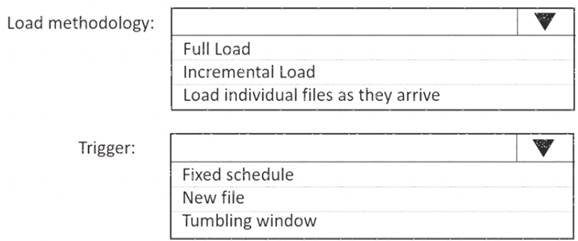
Reference:
https://k21academy.com/microsoft-azure/azure-data-engineer-dp203-q-a-day-2-live-session-review/
- (Exam Topic 3)
You have an on-premises data warehouse that includes the following fact tables. Both tables have the following columns: DateKey, ProductKey, RegionKey. There are 120 unique product keys and 65 unique region keys.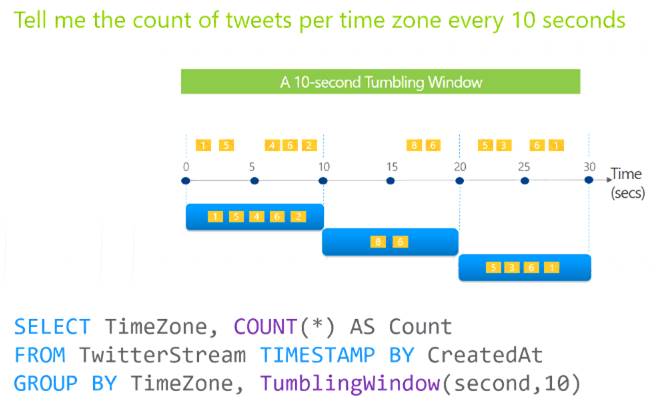
Queries that use the data warehouse take a long time to complete.
You plan to migrate the solution to use Azure Synapse Analytics. You need to ensure that the Azure-based solution optimizes query performance and minimizes processing skew.
What should you recommend? To answer, select the appropriate options in the answer area.
NOTE: Each correct selection is worth one point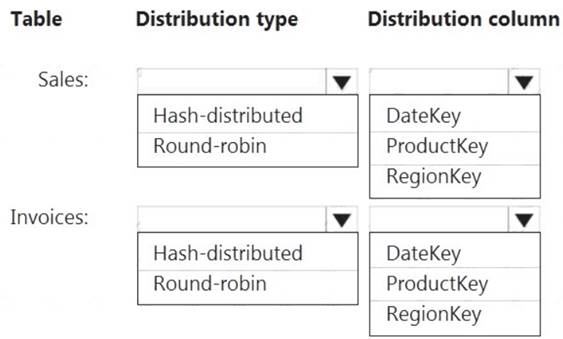
Solution:
Box 1: Hash-distributed
Box 2: ProductKey
ProductKey is used extensively in joins.
Hash-distributed tables improve query performance on large fact tables. Box 3: Round-robin
Box 4: RegionKey
Round-robin tables are useful for improving loading speed.
Consider using the round-robin distribution for your table in the following scenarios:  When getting started as a simple starting point since it is the default
When getting started as a simple starting point since it is the default If there is no obvious joining key
If there is no obvious joining key If there is not good candidate column for hash distributing the table
If there is not good candidate column for hash distributing the table  If the table does not share a common join key with other tables
If the table does not share a common join key with other tables If the join is less significant than other joins in the query
If the join is less significant than other joins in the query  When the table is a temporary staging table
When the table is a temporary staging table
Note: A distributed table appears as a single table, but the rows are actually stored across 60 distributions. The rows are distributed with a hash or round-robin algorithm.
Reference:
https://docs.microsoft.com/en-us/azure/sql-data-warehouse/sql-data-warehouse-tables-distribute
Does this meet the goal?
Correct Answer:
A
- (Exam Topic 3)
You have the following Azure Data Factory pipelines
• ingest Data from System 1
• Ingest Data from System2
• Populate Dimensions
• Populate facts
ingest Data from System1 and Ingest Data from System1 have no dependencies. Populate Dimensions must execute after Ingest Data from System1 and Ingest Data from System* Populate Facts must execute after the Populate Dimensions pipeline. All the pipelines must execute every eight hours.
What should you do to schedule the pipelines for execution?
Correct Answer:
C
Schedule trigger: A trigger that invokes a pipeline on a wall-clock schedule. Reference:
https://docs.microsoft.com/en-us/azure/data-factory/concepts-pipeline-execution-triggers
- (Exam Topic 3)
You have an Azure Data Lake Storage account that contains a staging zone.
You need to design a dairy process to ingest incremental data from the staging zone, transform the data by executing an R script, and then insert the transformed data into a data warehouse in Azure Synapse Analytics.
Solution: You use an Azure Data Factory schedule trigger to execute a pipeline that copies the data to a staging table in the data warehouse, and then uses a stored procedure to execute the R script.
Does this meet the goal?
Correct Answer:
A
If you need to transform data in a way that is not supported by Data Factory, you can create a custom activity with your own data processing logic and use the activity in the pipeline.
Note: You can use data transformation activities in Azure Data Factory and Synapse pipelines to transform and process your raw data into predictions and insights at scale.
Reference:
https://docs.microsoft.com/en-us/azure/data-factory/transform-data
- (Exam Topic 3)
You have a Microsoft SQL Server database that uses a third normal form schema.
You plan to migrate the data in the database to a star schema in an Azure Synapse Analytics dedicated SQI pool.
You need to design the dimension tables. The solution must optimize read operations.
What should you include in the solution? to answer, select the appropriate options in the answer area. NOTE: Each correct selection is worth one point.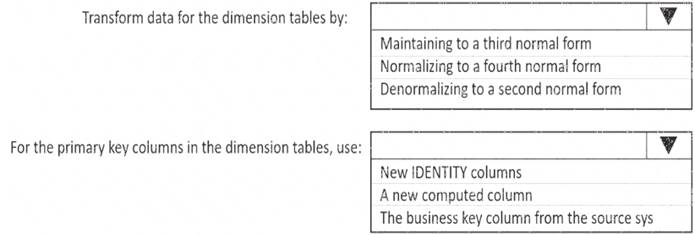
Solution:
Text, table Description automatically generated
Box 1: Denormalize to a second normal form
Denormalization is the process of transforming higher normal forms to lower normal forms via storing the join of higher normal form relations as a base relation. Denormalization increases the performance in data retrieval at cost of bringing update anomalies to a database.
Box 2: New identity columns
The collapsing relations strategy can be used in this step to collapse classification entities into component entities to obtain at dimension tables with single-part keys that connect directly to the fact table. The single-part key is a surrogate key generated to ensure it remains unique over time.
Example:
Diagram Description automatically generated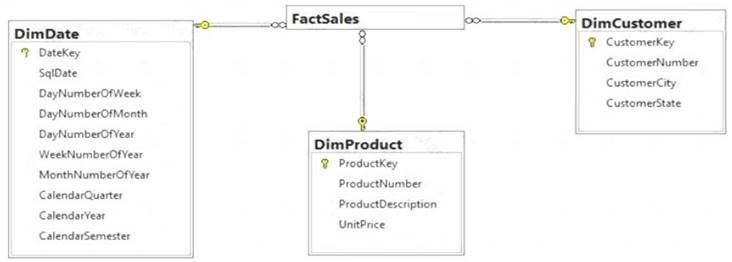
Note: A surrogate key on a table is a column with a unique identifier for each row. The key is not generated from the table data. Data modelers like to create surrogate keys on their tables when they design data warehouse models. You can use the IDENTITY property to achieve this goal simply and effectively without affecting load performance.
Reference:
https://www.mssqltips.com/sqlservertip/5614/explore-the-role-of-normal-forms-in-dimensional-modeling/ https://docs.microsoft.com/en-us/azure/synapse-analytics/sql-data-warehouse/sql-data-warehouse-tables-identity
Does this meet the goal?
Correct Answer:
A